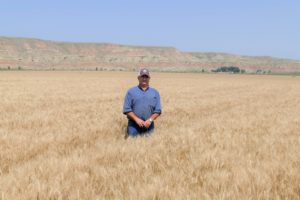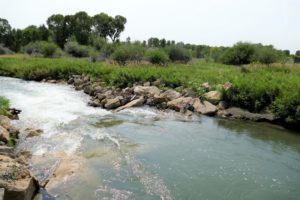
Bill’s family began farming in Meeteetse, Wyoming, in the 1800s.
By Grant Stumbough, Wyoming FSA Public Affairs & Outreach Specialist
Bill Schlenker’s family has been farming in Meeteetse, Wyoming, since the 1800s. Bill and his family are carrying on the family legacy, successfully farming the arid and productive land.
Irrigation and Innovation
In 1893, the Schlenker family filed for water rights on the Greybull River and are considered one of the pioneers of crop irrigation in the country. More than a century later, Bill runs the farm with his wife, Jennie, son, Richard, and brother, Neil.
“I love to farm, and I deeply care about the land. I have wanted to be a farmer since I was a small boy,” Bill said. “I like to watch my crops grow with my son standing by my side. Every year, we want to grow a better crop than the year before.”
The Schlenkers grow sugar beets, dry beans, corn, malting barley, wheat, and alfalfa. According to Bill, it’s essential to their operation to irrigate the crops during the growing season, as the area only receives around 14 inches of annual precipitation.
“Over the years, we have worked with various agencies and organizations to build wildlife friendly reservoirs, diversions, head-gates, and extensive canal systems to capture and utilize water from the Greybull River to make our farming operations productive and successful,” he said.
Snowpack and Spring Rains
During the first week of July 2017, runoff from mountain snowpack combined with heavy spring rains caused extensive flooding in the area.
“The reservoirs were full, and the flood water had nowhere to go but downstream, washing out numerous concrete diversions, ripping out head gates, tearing out culverts, and carving huge channels along the way,” Bill said. “In some places the mighty flood waters had changed the course of the Greybull River. Most of the irrigation structures were destroyed, and we knew we were in deep trouble.”
The Schlenkers worked with USDA’s Farm Service Agency in Park County, Wyoming to apply for the Emergency Conservation Program, which helps farmers and ranchers repair damage to farmland caused by natural disasters.
The program provided the Schlenkers with financial assistance to repair their irrigation canals and replace the washed-out head gates and culverts.

Financial assistance through the Emergency Conservation Program allowed the Schlenkers to make repairs after extensive flooding damaged their irrigation canals.
Recovery and Restoration
Large square rocks from the surrounding hillside were used as riprap to stabilize the canals, as well as protect the head gates from future flood damage. The repaired canals have provided an even and steady water flow, while the large rocks used to divert irrigation water have created deep pools enabling the replaced head gates to provide a constant and adjustable flow of water for reliable and efficient irrigation.
“This is a permanent fix and is built to last for generations,” said Bill.
The overall restoration project also provided excellent habitat for the Yellowstone cutthroat trout, which has been classified as a sensitive species by state and federal wildlife agencies. The stabilized canals have improved water quality and will be key in mitigating future flood damage.
“This ECP project has educated the entire community on how to improve the design of water diversions and irrigation canals,” Bill said. “This project has protected the resource and has provided a huge public benefit. Without assistance we could have only afforded a temporary fix.”
The Schlenker family has participated in several other USDA programs, including the Agriculture Risk Coverage and Price Loss Coverage Programs, Environmental Quality Incentives Program, Agricultural Management Assistance, and Conservation Security Program.
More Information
USDA offers a variety of risk management, disaster assistance, loan, and conservation programs to help agricultural producers in the United States weather ups and downs in the market and recover from natural disasters as well as invest in improvements to their operations. Learn about additional programs.
For more information about USDA programs and services, contact your local USDA service center.
JOIN THE CONVERSATION
For the digital version of this blog, visit #FridaysOnTheFarm.
Follow the #FridaysOnTheFarm story series and other news you can use on farmers.gov and @Farmersgov Twitter.





